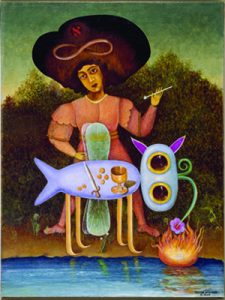Jewish Juggler
Victor Brauner was an iconic Romanian Jewish painter and sculptor. As a young artist, he was expelled from the School of Fine Arts in Bucharest, where his work was considered scandalous. Brauner embraced Dadaism in 1929, settling in Paris in 1930, where he was introduced to the Surrealists. Unable to captivate the Parisian art scene, he slunk home to Bucharest in 1935.
World War II left Brauner isolated in southern France, though he maintained contact with other Surrealists in Marseilles. After the Nazis invaded France, he took refuge in Switzerland. Lacking painting materials, the artist began experimenting by mixing hot wax with pigments (encaustic painting) and also developed a graffito (scratching) technique. He returned to Paris at war’s end, in 1945.
Brauner’s postwar art borrows heavily from tarot cards, which figure in many other Surrealist works. His Surrealist uses the juggler card as a self-portrait. The juggler embodies artistic creativity, the capacity to utilize intelligence, wit, and initiative to invent one’s own personality, playing with the future as the juggler twirls his baton.
 Solomon R. Guggenheim Foundation, Peggy Guggenheim Collection, Venice, 1976
Solomon R. Guggenheim Foundation, Peggy Guggenheim Collection, Venice, 1976The Surrealist
Artist Victor Brauner (1903–1966)
Created Paris, 1947
Media Oil on canvas
Location Peggy Guggenheim Foundation, Venice
Style Surrealism
Glowing across the juggler’s oversized, eccentric hairdo, the letter alef and the infinity symbol represent both beginning and end. Other motifs signify the four elements – fire, water, earth, and air – conveying some metaphysical, enigmatic message.
Brauner died in Paris in 1966 after a protracted illness. He chose his own epitaph: “Painting is life, the real life, my life.”

Victor Brauner
